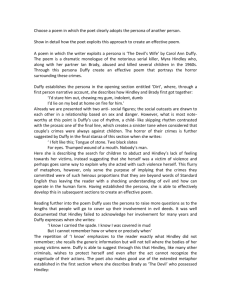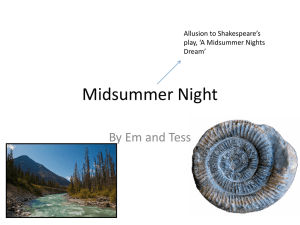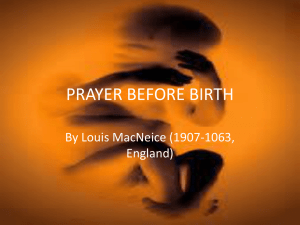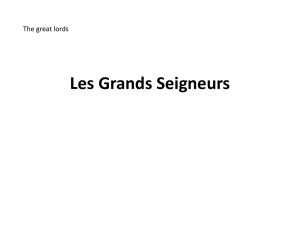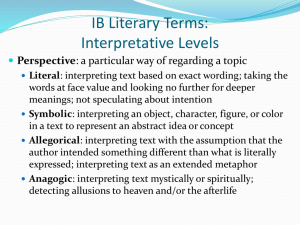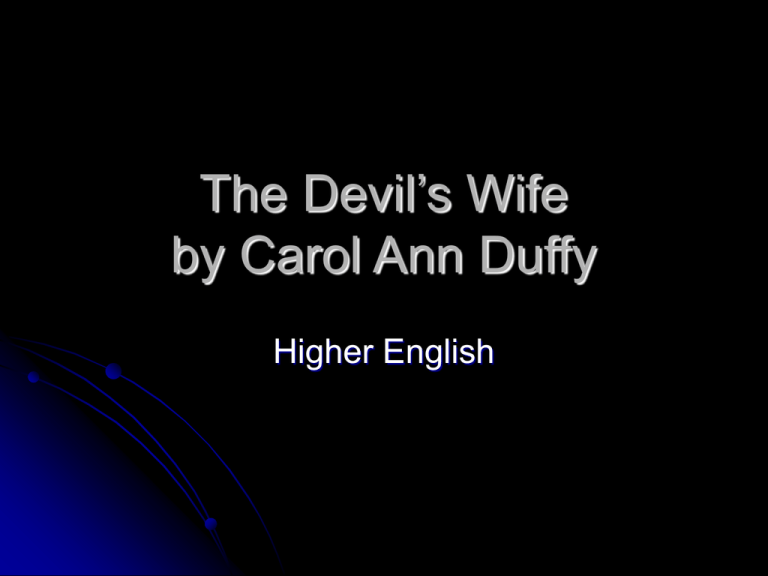
The Devil’s Wife
by Carol Ann Duffy
Higher English
Background
This poem is about Myra Hindley who, together with Ian
Brady, was convicted of the sexual assault, torture and
murder of several children in 1965. She was originally
sentenced to 25 years in prison, but successive Home
Secretaries lengthened this (none of them wanting to be
remembered as having released her) until eventually she
died in prison in 2001. Ian Brady is still held in Ashworth
hospital, where he has been on hunger strike for a long
time. The relationship between these two has been
called a classic ‘folie à deux’, where neither would have
committed such terrible crimes on their own, but together
a kind of evil chemistry drove them on.
Myra Hindley and Ian Brady
1. DIRT
In the usual way, this poem is a monologue, the voice that of Myra Hindley
herself. She joined the office where Brady worked about 12 months after
him and immediately knew that he was different from the dull and worthy
boys she had gone out with before. Neither Brady nor Hindley are referred
to by name, but only as ‘the devil’ and ‘the devil’s wife’.
In the first stanza, we see Brady through Hindley’s eyes
Different. Fancied himself. Looked at the girls
in the office as though they were dirt. Didn’t flirt.
Didn’t speak. Was sarcastic and rude if he did.
She sees this as a challenge and responds by being ‘insolent, dumb’ even
though she is secretly ‘on fire for him’. Her tactics worked
I scowled and pouted and sneered. I gave
as good as I got till he asked me out.
There is no mention in the poem of Brady’s admiration of Hitler and
his works, nor of his twisted philosophy that held that rape and
murder were ‘the supreme pleasure’ a notion he had got from
reading the works of the Marquis de Sade. These ideas he shared
with Hindley, in addition to his identification with Raskolnikov in
Dostoevsky’s novel ‘Crime and Punishment’. All that we are told by
the poem’s narrator is
In his car
he put two fags in his mouth and lit them both.
He bit my breast. His language was foul. He entered me.
This description is a mixture of the intimate and the sadistic and the
final phrase is chosen deliberately to suggest not merely sexual
intercourse but the taking over of Hindley’s personality, reinforced by
We’re the same, he said. That’s it. I swooned in my soul.
This idea reinforces the notion of ‘the devil’s wife’ having found a
‘soulmate’.
The idea of burying a doll in the woods is a reference to the way they buried
several of their victims on Saddleworth Moors, which led to them being
christened ‘The Moors Murderers’ by the press. One of them, Keith Bennett,
has never been found.
I went mad for the sex. I won’t repeat what we did.
Not surprisingly, since rape, torture and murder were part of it and even
hardened policemen felt sick after listening to a cassette tape they had
made of the last moments of ten year old Lesley Ann Downey. The voice of
Hindley continues talking about the way they hunted for their victims in
woods, playgrounds or fairgrounds.
I’d walk around on my own. He tailed.
She, the lone woman, acted as decoy, although, as she says, she felt like
‘Nobody’s Mam.’ Her famous mugshot (see above) is the source for how
she felt
Tongue of stone. Two black slates
for eyes. Thumped wound of a mouth.
2. MEDUSA
This part of the poem is concerned with Hindley’s arrest
and imprisonment. Since there had never been a case
like this before, where a woman was involved in the
sexual abuse and murder of children, she was treated as
a monster by the press and every detail of her
appearance and demeanour was scrutinised closely for
clues to her personality. Still under the influence of
Brady, she showed no remorse at their trial for the
terrible crimes she had committed. This is reflected in
the understatement used by Duffy as Hindley’s voice
continues her story.
The first stanza is a reference to the murder and burial of their first victim,
sixteen year old Pauline Reade, who had been wearing a pink party frock –
‘the doll’. Hindley claimed she had helped to bury the body after Brady had
raped and murdered the girl; he claimed she been involved in the assault
and murder as well. Duffy uses repetition
I know it was me who was there.
I know I carried the spade. I know I was covered in mud.
as a contrast to the final line
But I cannot remember how or when or precisely where.
Following the first line this gives a dreamlike quality to Hindley’s confession
of being partly involved. She was unable to remember the exact location of
the bodies and Pauline Reade was not found until 1987 – identifiable only
by the pink dress.
The second stanza shows Duffy imagining Hindley’s response to the public
comments about her looks and her attitude. She had changed her
appearance and dress to please Brady and had very bleached hair, short
skirts and high boots.
He held my heart in his fist and he squeezed it dry.
She had followed Brady in everything, including a total lack of compassion
and remorse, summed up in the final two lines of the stanza
I gave the cameras my Medusa stare.
I heard the judge summing up. I didn’t care.
Hindley is associated with Medusa in the idea of the feminine turned evil,
her hard stare at the camera equated to the Gorgon’s ability to petrify those
she looked on. She is aware of the public’s opinion,
I was left to rot. I was locked up, double-locked.
I know they chucked the key. It was nowt to me.
In a high security prison, she had to be kept separate from other prisoners
for her own safety – ‘double-locked’. She was also aware that her sentence
was a long one and Duffy uses a rhyming line to emphasise both her
Mancunian accent and her appearance of bravado. She continued to
communicate with Brady in a secret code they had devised. They even
asked permission to marry.
I wrote to him every day in our private code.
I thought in twelve, fifteen, we’d be out on the open road.
This unrealistic hope is quashed in the fourth stanza and she has to face
the fact that she will never see Brady again. Duffy uses the idea of the devil
and people’s view of women to express both public sentiment and Hindley’s
feelings.
But life, they said, means life. Dying inside.
This appears to refer to the way in which successive Home
Secretaries, beginning with Michael Howard, lengthened the original
sentence given by the judge. The final phrase can mean both being
in prison until your death, but also undergoing a personal and
spiritual ‘internal death’.
The Devil was evil, mad, but I was the Devil’s wife
which made me worse. I howled in my cell.
If the Devil was gone then how could this be hell?
The question posed in the last line is one of Duffy’s thought
provoking ideas about how women can pay the price for being
manipulated by men.
3. BIBLE
This part of the poem refers to Myra Hindley’s steadfast denials of her involvement in
the sexual abuse and murders. Whereas Brady accepted the fact of his guilt and his
sentence, she continued to deny any part of them, mounting an appeal with the help
of Lord Longford. The first stanza relates to these denials, the lack of punctuation and
grammatical syntax giving an idea of the desperation she feels.
I said No not me I didn’t I couldn’t I wouldn’t.
Can’t remember no idea not in the room.
Hindley claimed to have stayed in the car while the murders on the moors were
committed, and to have been out of the room when Lesley Ann Downey was killed.
The bible is a reference to the fact that Hindley re-discovered her Catholic faith while
in prison and a number of people were convinced of her sincerity, despite the fact that
she continued to deny her guilt up until 1987. She published a long document stating
that she had been manipulated by Brady, who was solely responsible for all the actual
murders.
I never not in a million years it was him.
The second stanza deals with her long campaign to win her freedom, which went up
as far as the European Court.
I said send me a lawyer a vicar a priest.
Send me a TV crew send me a journalist.
Can’t remember not in the room. Send me
a shrink where’s my MP send him to me.
This string of commands, encompassing the church, the law, the media, psychiatric
medicine and politics depicts someone determined to explore every avenue. Her
claims, however, remain the same
Can’t remember no idea it was him it was him.
By the constant use of repetition in this part of the poem, Duffy creates a voice both
of determination and denial. Written in the form of a conventional sonnet, replacing
rhyming couplet with repetition at the end, its irony consists of the breakdown of a
relationship and of the narrator’s sanity.
Many years later, in 2000, Hindley did take part in a TV programme, which was
condemned by the relatives of the murdered children
4. NIGHT
This short part of the poem refers to Hindley’s decision in 1987 to confess to her part
in all the crimes. By this time she was estranged from Brady and his influence over
her had waned. Duffy creates a voice that speaks of ‘the long dark night of the soul’,
an expression which, in religious terms, means the spiritual suffering that leads to
repentance and forgiveness.
In the long fifty-year night,
these are the words that crawl out of the wall:
Suffer. Monster. Burn in Hell.
These were the sentiments expressed by the victims’ families and many members of
the public. Hindley came to understand them.
When morning comes,
I will finally tell.
Amen.
The ‘amen’ is to show a spiritual reconciliation which she seems to have made with
herself, with the decision to confess.
5. APPEAL
The title of this part of the poem has a double meaning, since it can stand
for a legal appeal, which Hindley never stopped trying for. Even when her
appeal to the House of Lords was unsuccessful, ‘given the uniquely terrible
nature of the crimes’, she was taking her appeal to the European Court of
Human Rights when she died.
On the TV programme in 2000, Hindley said she wished she had been
hanged. Ironically the death penalty has been abolished only some few
months before the Moors Murder trial. In a way Hindley felt she might have
achieved closure for herself and the victims’ families through her execution,
which is the subject of the final part of the poem, which looks at all the
various methods of judicial killing employed at different times and by
different cultures.
Duffy’s repetitive use of ‘If’ at the start of each line makes this stanza both a
list of methods of execution and a question about whether such methods
should be contemplated
If life means life means life means life
There seems to be an implicit question here about whether taking
someone’s life violently is any different to locking them away with no
possibility of release. But the poem itself finishes on a much bigger
question
But what did I do to us all, to myself
When I was the Devil’s wife?
What she did to herself was to lose her humanity and her femininity.
What she did to ‘us all’ was, in many cases, to cause the public to
lose their sense of perspective and to provide a figure upon whom
they felt justified in pouring out every form of invective, and in
treating as less than human – after all she was ‘the Devil’s wife’ and
thus far removed from the human race. Duffy is warning us that to
ignore the possibility of this evil within ourselves is unwise. Myra
Hindley was an ordinary secretary until she met Ian Brady, just as
many other ordinary people can become torturers and killers, given
the right circumstance.


